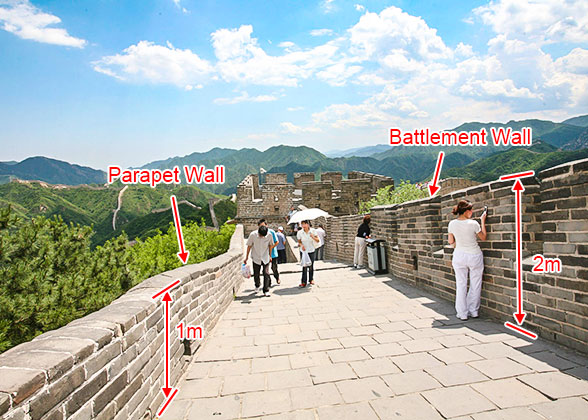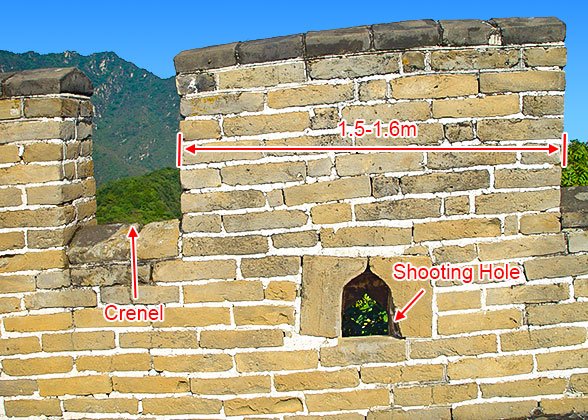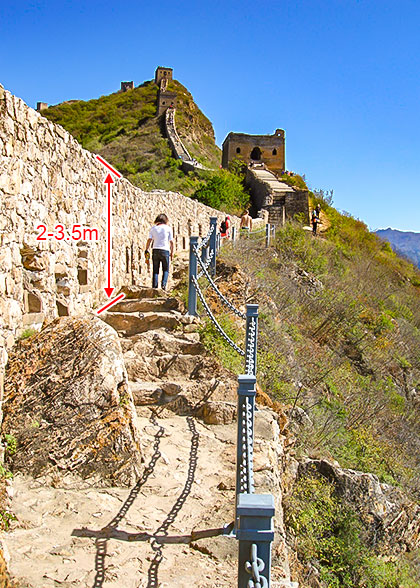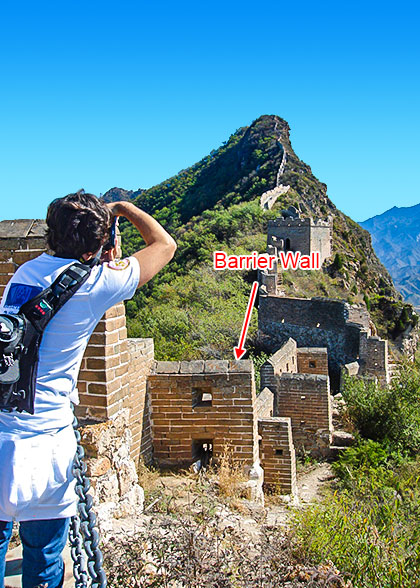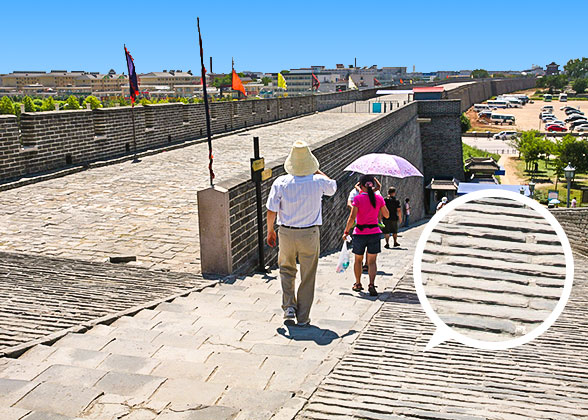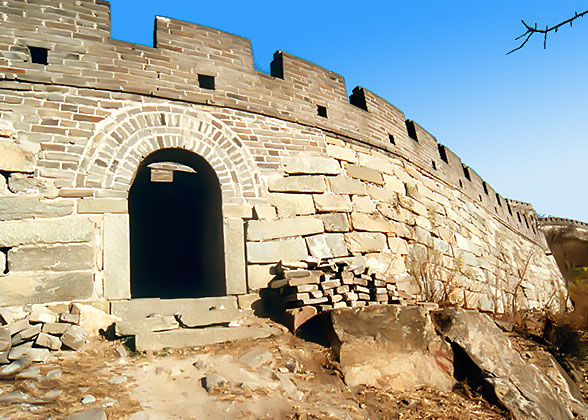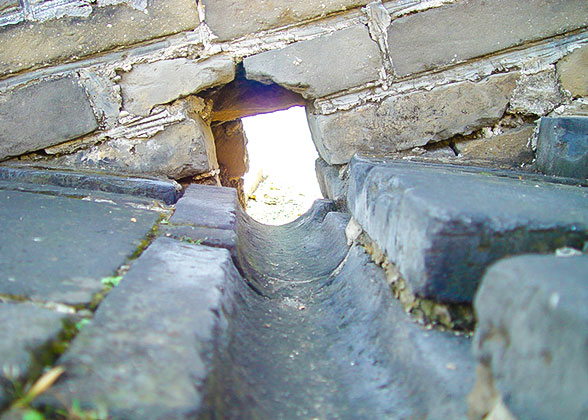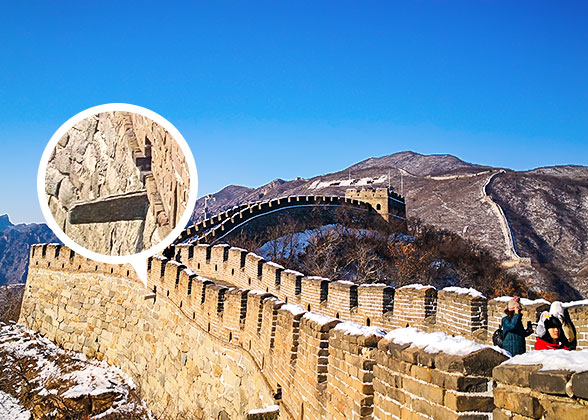Defensive Wall Structure of China Great Wall
The walls are the main bodies of the China Great Wall, linking beacon towers and passes into a continuous defensive line. They mainly consist of battlement, parapet and barrier walls, horse ramps and other parts to block invaders and protect soldiers during the battles.![]() See details about What is the China Great Wall made of?
See details about What is the China Great Wall made of?
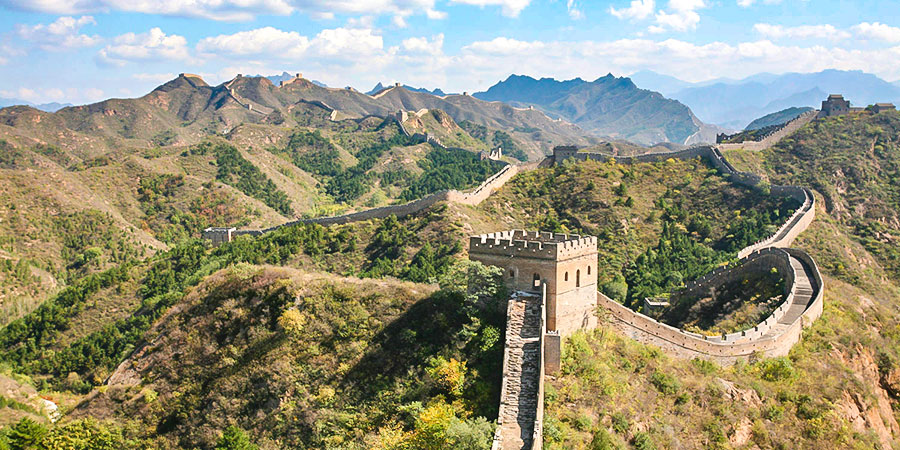 |
Their heights differ depending on the surrounding terrain. In flat areas and places of military importance, it was built quite high. While in the steep mountains and places of less military importance, it was built comparably lower to save financial and human resources. On average, they vary from 6 to 7 meters (20 to 23 feet) in height from top to bottom.![]() See details about
See details about
How tall is the China Great Wall?
How wide is it?
Battlement Wall
It was built on the outer side with a width of 40-50 cm (15.7-19.7 in) and a height of about 2 meters (6.6 feet). On it are crenels and holes to shoot and watch enemies. On some sections, there are also stone missile holes on the battlement wall, used to release rolling logs and stone missiles against the enemies. The walls between the crenels are about 1.5-1.6 meters (1.6-1.7 yards) to provide cover for two soldiers during battles.
|
|
Parapet Wall
In Chinese, it is called Nuqiang or Yuqiang, literally translated as "Women's Wall", to indicate that it is low enough to allow a woman to climb over. It was built on the inner side to ensure the safety of soldiers and horses on the Great Wall, often 1 meter (3.3 feet) high.
Single Wall
As the name suggests, it was built only on one side. It was usually a thin wall built on extremely steep mountain slopes. In this area, the regular way of building a double-sided wall is impossible. The lofty peaks serve as natural barriers on the other side. The height varies according to the terrain, often measuring 2-3.5 meters (6.6-11.5 feet) tall. A famous and steep single wall is located at Simatai Great Wall in Beijing.
|
|
Barrier Wall
It is built perpendicular to the battlement walls, also called Obstacle Wall or Walls-within-Walls. When the enemies got into the wall, allied soldiers could use barrier walls to provide cover for themselves during the fight.
Top Surface of the Walls
It was usually 4-5 meters (4.4-5.5 yards) wide, enough to allow 10 soldiers to walk and 10 horses to gallop shoulder by shoulder. In the flat areas, it was paved with 3 or 4 layers of square bricks and the gaps were filled with lime, so grass could not grow to damage the floor. In steep areas, rectangular stones were used to build stairs instead of a flat floor.
Horse Ramp
Also called Bridle Path, it was usually laid beside the gate tower to lead people and horses to the top of the wall from ground. It measures about 5-6 meters (5.5-6.6 yards) wide. A parapet wall serving as railing was built on one side of it. The incline is 30 degrees and the bricks were placed with their lateral surfaces upside to provide anti-slip.
|
|
Quanmen Gate
Usually on the inner side of the Great Wall, at regular intervals, there are arched doors. When war was coming, soldiers stationed under the walls could pass through these doors to the top of the wall to fight.
Drainage System
To drain water from the Great Wall, workers built barrel drains at certain intervals. Rain water could be drained to the outside through the mouth of the barrel drains which extended out from the wall about 1 meter (1.1 yards). The drainage system has protected the wall from the erosion of rain water over a long period of time.
|
|
![]() Further Reading:
Further Reading:
![]() How was the Great Wall of China defended?
How was the Great Wall of China defended?
![]() Wall Structure of Great Wall
Wall Structure of Great Wall
During the Ming Dynasty, bricks became the main material. Lime mar and sticky rice juice were also used as cementation materials. That's why Ming walls are still preserved well till now.
Therefore, you can conclude that the construction ended in the Ming Dynasty. In total, the construction lasts more than 2000 years.
